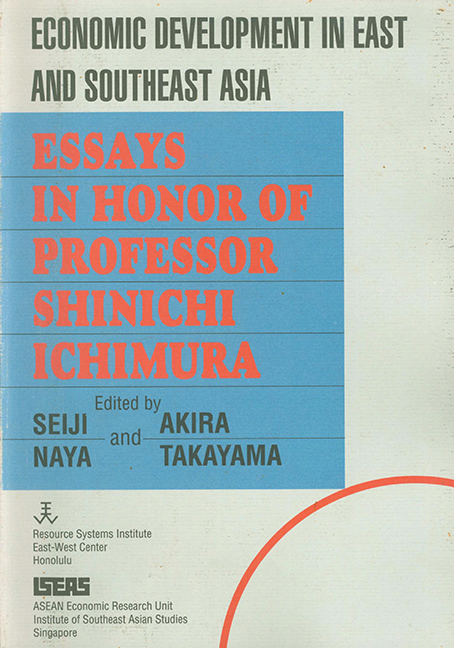Book contents
- Frontmatter
- Preface
- Shinichi Ichimura, 1925-
- CONTENTS
- Introduction
- Contributors to This Volume
- I Structural Change and Economic Development in Developing Asia in the 1990s
- II Explaining the Success of the Four Little Dragons: A Survey
- III Taiwan's Economic Miracle: A Singaporean Perspective
- IV Singapore's Experience of Industrial Restructuring: Lessons for the Other Asian NIEs
- V Korean Industrial Policies for Declining Industries
- VI Vietnam: Recent Economic Developments and the World Economy
- VII Transition from Import Substitution to Export Expansion: The Thai Experience
- VIII Adjustment Problems of a Small Oil-Exporting Country: Did Indonesia Suffer from the Dutch Disease?
- IX A Quarterly Econometric Model of the Hong Kong Economy
- X The Effect ofRicardian Rent Extracting on Macroeconomic Performance
- XI Direct Foreign Investment and the Economic Development of Korea
- XII Japanese Investment in Thailand: Looking Back and Into the Future
- XIII The Effects of Direct Foreign Investment on Taiwan: A Macroeconometric Investigation
- XIV A Reform of the Foward Foreign Exchange Market and Foreign Exchange Rate Determination Policy in Korea, with Foreign Exchange Policy Experiences of Taiwan
- XV Interest Rate and Foreign Exchange Liberalization in Taiwan in the 1980
- XVI Manifold Dilemmas behind External Debt Management
- XVII Agricultural Growth and Food Imports in Developing Countries: A Reexamination
- XVIII The Transformation of Rural Asia and Economic Development Theory and Policy
- XIX The ASEAN Summit and ASEAN Economic Cooperation
- XX The Role of Developing Countries in the New GATT Round
- XXI The Emerging Global Economy and the Role of the Asian NIEs
- Index
Introduction
Published online by Cambridge University Press: 21 October 2015
- Frontmatter
- Preface
- Shinichi Ichimura, 1925-
- CONTENTS
- Introduction
- Contributors to This Volume
- I Structural Change and Economic Development in Developing Asia in the 1990s
- II Explaining the Success of the Four Little Dragons: A Survey
- III Taiwan's Economic Miracle: A Singaporean Perspective
- IV Singapore's Experience of Industrial Restructuring: Lessons for the Other Asian NIEs
- V Korean Industrial Policies for Declining Industries
- VI Vietnam: Recent Economic Developments and the World Economy
- VII Transition from Import Substitution to Export Expansion: The Thai Experience
- VIII Adjustment Problems of a Small Oil-Exporting Country: Did Indonesia Suffer from the Dutch Disease?
- IX A Quarterly Econometric Model of the Hong Kong Economy
- X The Effect ofRicardian Rent Extracting on Macroeconomic Performance
- XI Direct Foreign Investment and the Economic Development of Korea
- XII Japanese Investment in Thailand: Looking Back and Into the Future
- XIII The Effects of Direct Foreign Investment on Taiwan: A Macroeconometric Investigation
- XIV A Reform of the Foward Foreign Exchange Market and Foreign Exchange Rate Determination Policy in Korea, with Foreign Exchange Policy Experiences of Taiwan
- XV Interest Rate and Foreign Exchange Liberalization in Taiwan in the 1980
- XVI Manifold Dilemmas behind External Debt Management
- XVII Agricultural Growth and Food Imports in Developing Countries: A Reexamination
- XVIII The Transformation of Rural Asia and Economic Development Theory and Policy
- XIX The ASEAN Summit and ASEAN Economic Cooperation
- XX The Role of Developing Countries in the New GATT Round
- XXI The Emerging Global Economy and the Role of the Asian NIEs
- Index
Summary
The dynamic economic performances of the East and Southeast Asian nations have caught the attention of many around the world. During the 1970s and 1980s, these economies as a group grew faster than most other countries in the world. Over the period 1970-79, for example, real GDP grew at an annual average rate of more than 9 percent in the newly industrialized economies (NIEs) — -which include Hong Kong, Korea, Singapore, and Taiwan — and more than 7 percent in most of the ASEAN (Association of Southeast Asian Nations) countries. Even in the Philippines, real GDP grew at 6 percent in the 1970s, which was higher than growth in most other developing countries in the world in the same period. In the 1980s, despite the turndown in the global economy, the trend has continued with real GDP in the NIEs and the ASEAN economies (again except for the Philippines) growing at about 7 and 5 percent, respectively.
As a result of their phenomenal performance, these countries have increased their shares of world output and have also raised their share of world exports. In 1970, the NIEs and ASEAN countries comprised 0.8 percent and 1.0 percent of total world output. By 1987, these shares had increased to 1.8 percent and 1.2 percent, respectively. The growing importance of these economies in terms of world exports is even more dramatic. From 2.2 percent and 1.6 percent in 1970, the share of exports from the NIEs and ASEAN countries to total world exports have grown to 8.3 percent and 2.4 percent, respectively, in 1988.
Indeed, this is the only region where some countries have graduated or are graduating from the ranks of the Third World. The successful development experiences of these Asian economies can serve as a laboratory to enrich economic theory and a large number of projects have been devoted to studying and analyzing their development strategies. In addition, the success of the NIEs and the nations of ASEAN has had a very favorable demonstration effect. As a result, countries such as China, India, and nations in Latin America have shown a great deal of interest in the development experiences of the East and Southeast Asian economies.
This volume represents a comprehensive collection of papers covering a wide range of development issues and problems the East and Southeast Asian economies have encountered, are facing, or -will be confronted with in the near future.
- Type
- Chapter
- Information
- Economic Development in East and Southeast AsiaEssays in Honor of Professor Shinichi Ichimura, pp. xiii - xviiiPublisher: ISEAS–Yusof Ishak InstitutePrint publication year: 1990



